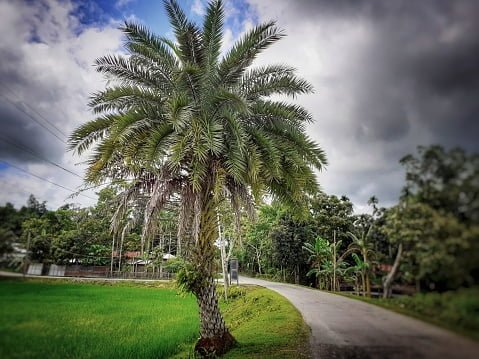Sylvester Palm
Classy and low-maintenance Sylvester palms are easy to grow and go well in most backyard landscaping schemes.
Sylvester Palm is one of the most popular palm trees in the world, and its scientific name is Phoenix sylvestris. Elegant residences and famous golf courses often include this stunning palm tree as an avenue planter. An indoor Sylvester Palm Tree may thrive. Alabama, Arizona, Arkansas, California, Georgia, Louisiana, Mississippi, Nevada, Oregon, and Texas are just a few of the states where this palm may be found.

When it comes to the beauty of the Canary island date palm in a smaller, silvery package, the Sylvester is a fantastic option for those who want it but lack the space.
As one of our most beautiful and resilient palms, it bears an edible fruit (said to be sweet) and is used to create an alcoholic beverage by Indians in the palm’s original country (hence the common name “Toddy Palm”).
Specifications for the Sylvester palm plant
Sylvester palms may grow to a height of 40 feet, although they do so slowly.
Young trees lie low to the ground, ultimately producing a beautiful trunk with diamond-shaped scars on the leaf base. To achieve the greatest results, you may get this “diamond cut” done by an expert.
It’s resilient enough to withstand temperatures as low as Zone 9. Drought and salt tolerance are both moderate.
When compared to other types of foliage, the silvery blue-green fronds of this plant stand out.
There are numerous silvery blue-green fronds on Sylvester Palms, and they rise straight from the stem. The pamphlets are neatly stacked one on top of the other, creating a pleasing visual effect. Sylvester trunks have “boots” where old leaflets used to be if they are left untreated. For a more refined appearance, the tops of these boots may be trimmed and fashioned into a straight or diamond cut.
Stalks up to three feet long bear blooms ranging in colour from creamy white to pastel yellow. Upon maturity, the blossoms bear little, single-seeded dates, which are a dark purple when ripe. Drying the seeds, juicing them, or preserving them in jams and jellies are common methods of preserving them.
One of the toughest palms around. Temperature-resistant Sylvester palms are also drought-suffering and somewhat salt-tolerant. They can grow to a maximum height of 50 feet, but they do so slowly. They thrive on sand as well as almost any other well-drained soil. Direct sunshine and enough space are ideal conditions for Sylvesters.
Among the Sylvester Date Palm’s, delicate white blossoms and branching inflorescence, which is 2-3 feet long, are the plant’s small white flowers and fruits. Dioecious, the Sylvester Palm produces both male and female blooms at the same time. Oval fruits, approximately one inch in diameter, follow the flowers and become purple-black when mature. It’s delicious and easy to modify fruits. Inside each one is a single seed.
Read About: Philodendron Oxapapense
Moderate growth is expected. With an average height and width of 50-60 feet and an average spread of 10-20 feet, the Phoenix Sylvestris is a fast-growing palm.
Use
Both indoor and outdoor use are permitted.
Planting Requirement
Temperature
Phoenix sylvestris, a cold-tolerant palm, can withstand temperatures as low as 15 degrees Fahrenheit. USDA Zones 8b (15-20 F) through 11 are ideal for growing it (above 40 F).
Light
Full sun to moderate shade is required for lighting.
Soil and Water
Moderate consumption of water is required. For a limited time, the Sylvester Palm can resist drought. It thrives on soil that is both wet and well-drained.
Do You Know About Italian Roses?
Pruning
It’s simple to keep everything in working order. Only pruning is needed to prevent the “skirt” of dead leaves on this palm. Apply high-quality palm fertilizer with a continuous release formula twice a year throughout the growing season to avoid nutritional shortages.
Propagation
Seeds are used for propagation.
